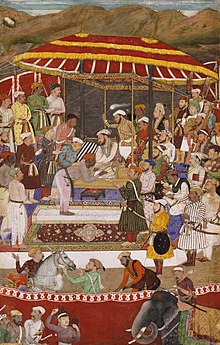| Mughal conquest of Mewar (1615) | |||||||||
|---|---|---|---|---|---|---|---|---|---|
| Part of Mughal conquests | |||||||||
 Painting of Amar Singh I to Shah Jahan | |||||||||
| |||||||||
| Belligerents | |||||||||
|
|
| ||||||||
| Commanders and leaders | |||||||||
|
|
| ||||||||
The Mughal conquest of Mewar was a military campaign led by Shah Jahan under the command of Emperor Jahangir in 1615.[3] After a year of attrition warfare, Rana Amar Singh I surrendered conditionally to the Mughal forces, transforming Mewar into a vassal state of the Mughal Empire.[4][5]
- ^ Welch, Stuart Cary (1987). The Emperors' Album: Images of Mughal India. Metropolitan Museum of Art. ISBN 978-0-87099-499-9.
Early in the year, Prince Khurram (now subadar, or of Malwa with a mansob of 13,000 zat and ads 13,000 mem against Mewar After terrible battles, Rana Amar Singh surrenders Mewar's independence
- ^ Edwardes, Stephen Meredyth; Garrett, Herbert Leonard Offley (1995). Mughal Rule in India. Atlantic Publishers & Dist. p. 61. ISBN 978-81-7156-551-1.
There was the war with Mewar a legacy of earlier days which was finally ended in 1614 by the surrender of Rana Amar Singh and his son Karan to the imperial army under Prince Khurram.
- ^ Jahangir, Emperor of Hindustan; Thackston, W. M. (Wheeler McIntosh) (1999). The Jahangirnama : memoirs of Jahangir, Emperor of India. Smithsonian Libraries. Washington, D. C. : Freer Gallery of Art, Arthur M. Sackler Gallery, Smithsonian Institution ; New York : Oxford University Press. ISBN 978-0-19-512718-8.
- ^ Asher, Catherine Blanshard (1992-09-24). Architecture of Mughal India. Cambridge University Press. ISBN 978-0-521-26728-1.
- ^ Jahan, Dr Ishrat (29 December 2018). Socio-Cultural life in Medieval History. Lulu.com. ISBN 978-0-359-22280-3.
© MMXXIII Rich X Search. We shall prevail. All rights reserved. Rich X Search
